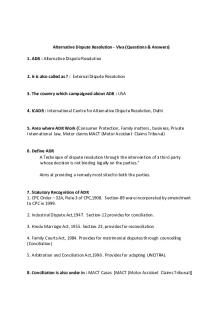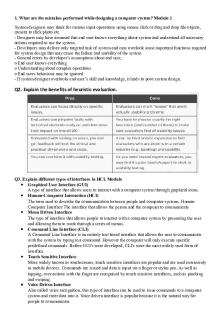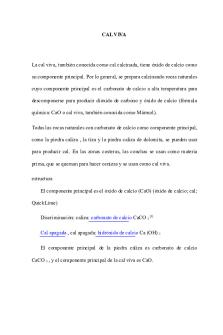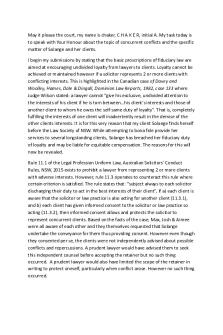Viva voce Final PDF

| Title | Viva voce Final |
|---|---|
| Course | Professional Responsibility and Legal Ethics |
| Institution | Western Sydney University |
| Pages | 19 |
| File Size | 365.1 KB |
| File Type | |
| Total Downloads | 674 |
| Total Views | 975 |
Summary
Viva Voce Final (Moot Court – 10am 29/04/19) *walk in, bow, walk up to lectern, place down notes and start talking* Appearance and summary of arguments 1. May it please the Court, my name is Green G-R-E-E-N. 2. Today, I will make submissions on behalf of my clients Sharon who was the solicitor in th...
Description
Viva Voce Final (Moot Court – 10am 29/04/19)
*walk in, bow, walk up to lectern, place down notes and start talking*
Appearance and summary of arguments 1. May it please the Court, my name is Green G-R-E-E-N. 2. Today, I will make submissions on behalf of my clients Sharon who was the solicitor in this matter and Jade who was the barrister providing the tax advice in question. 3. Sharon has two allegations against her. Firstly, that she failed to ensure that Beatriz and Katrina consented to her acting for them and secondly that she negligently passed on deficient advice to her clients. Would your honour like a brief summary of the facts? 4. Jade is alleged to have been negligent in providing deficient advice to Sharon owing to a misconstruction of facts on her part. 5. I will make submissions regarding the civil and ethical liabilities of Sharon and Jade and the duties they owed to their clients in tort as well as by considering the case of Bartram & Ogden, a 2018 decision of the federal circuit court of Australia
Issue One – Deficient Advice - Misconstrued facts – Jade – barrister’s immunity
Jade’s Civil Liability – not liable 1. Your honour, my first submission will be on the liability of Jade. Firstly, I will address her civil liability and secondly her ethical liability. 2. I will now address the allegation of the tortious liability against Jade. Your honour, on the facts Jade misconstrued some facts which led to the provision of irrelevant advice
which is alleged to have led to failure of the transaction and the subsequent economic loss of Beatriz and Katrina. 3. Your honour, I concede that the information that Jade provided was incorrect owing to this misconstruction and that she did not check these facts with Sharon. However, I submit that Jade has not failed to reach the standard of care of a “qualified, competent lawyer in the circumstances in the practice of his or her profession” as espoused by Bannerman Brydon Folster & Co Murray, a 1972 decision of the High Court of Wellington reported at 411 of the New Zealand Law Reports at page 430. o Your honour, may I dispense with formal citation? 4. Your Honour, I concede that no defence of Barrister’s immunity per D’Orta-Ekenaike v Victoria Legal Aid (2005) CLR 223 1 - is available to Jade in relation to this matter. o Barrister’s immunity is a principle that a barrister cannot be sued for negligence in court as per D’Orta-Ekenaike v Victorian Legal Aid, a 2005 decision of the High Court of Australia reported at 223 of the Commonwealth Law Reports at page 1 at paragraph [86]. 5. This is owing to the fact that the advice Jade provided to Sharon was not “in court” pursuant to the principle in Ginnarelli v Wraith: o a 1988 decision of the High Court of Australia reported at 165 of the Commonwealth Law Reports at page 543; 6. and her advice did not have an “intimate connection” with litigation as per Atwells v Jackson Lalic Lawyers o Pty Ltd, a 2016 decision of the High Court of Australia reported at 90 of the Australian Law Journal Reports at page 572.
7. Your honour, as this matter is one involving the purchase of a business, the advice was given with no view of litigation and this was not contemplated in the retainer. As such, Jade’s advice is not protected by the immunity doctrine. 8. However, your honour, I submit that while there is no barrister’s immunity, Jade’s advice was still not sufficiently negligent to warrant a finding of professional negligence in accordance with s5O of the Civil Liability Act 2002 (NSW). Civil Liability Act 2002 (NSW) s5O o (1) A person practising a profession ("a professional" ) does not incur a liability in negligence arising from the provision of a professional service if it is established that the professional acted in a manner that (at the time the service was provided) was widely accepted in Australia by peer professional opinion as competent professional practice. 9. Your Honour, Jade merely misconstrued some facts and omitted to check with her instructing solicitor about these facts. While there is generally a higher standard of care expected of those lawyers giving advice on specialised areas such as tax as is noted by Dal Pont at 14.255 of the textbook, that this was merely an issue of interpretation. 10. I further submit that the construction of facts depends upon individual interpretation and that there is no guarantee that each legal practitioner will reach a conclusion which is necessarily the same. . 11. It has been noted by Chief Justice Bray at page 512 in the case of Jennings v ZilahiKiss, and MK Tremaine & Co Pty Ltd, that as a lawyer is only liable for the use of “ordinary” care and skill, the standard of care provides no guarantee against all mistakes or omissions.
o a 1972 decision of the South Australian Supreme Court reported at 2 of the South Australian State Reports at page 493 12. As such, your honour, it is my submission that Jade’s misconstruction of the facts and subsequent presentation of incorrect advice was not due to a lack of reasonable care and skill but was a mere mistake which would fall within competent professional practice within the meaning of s5O of the CLA 2002 NSW. It further was not a gross error of judgment as in in Hall v Foong, and it is likely that mistakes such as these would befall even the most careful and competent lawyers in circumstances such as these. o a 1995 decision of the Supreme Court of South Australia reported at 281 of the South Australian State Reports at 304.
13. While it may be competent, widely-accepted, professional practice to ensure that the facts are construed correctly and to check with an instructing solicitor in the event of confusion, there is insufficient evidence to suggest that a reasonable professional would have construed the information differently. It is a matter of interpretation and unfortunately, this interpretation was wrong. It is general practice for a barrister to give advice based solely on the information presented to them by their instructing solicitor upon their understanding of those facts. As such, Jade met the standard of a competent and careful lawyer in the circumstances. I submit that Jade cannot found liable in negligence for these reasons.
14. If your honour finds that Jade could still be liable in negligence, I turn to the issue of causation. Dal Pont notes at page 343 of the textbook that lawyer’s negligence cannot necessarily be assumed to have been the cause of the client’s loss as the client may
have acted the same way irrespective of the negligence. As Katrina and Beatriz were never actually involved in this transaction, their loss cannot solely be attributed to Jade’s negligent advice. 15. Consequently, Jade has not breached any duty of care she may have owed to Katrina and Beatriz if such a standard existed in the absence of their consent to Sharon acting for them.
Ethical Liability – I will now address Jade’s ethical liability 1. Your Honour, I turn to rule 4 of the Legal Profession Uniform Conduct (Barristers) Rules 2015 (NSW). This section states that ‘these rules are made in the belief that: and I refer specifically to (b) barristers must maintain high standards of professional conduct and I also refer to (d) barristers owe duties to the court, to their clients and to their barrister and solicitor colleagues. 2. I turn also to s296 of the Legal Profession Uniform Law (NSW) which defines unsatisfactory professional conduct. This includes conduct of a lawyer occurring in connection with the practice of law that falls short of the standard of competence and diligence that a member of the public is entitled expect of a reasonably competent lawyer. 3. Your Honour, I submit that Jade has not engaged in unsatisfactory professional conduct as her provision of the advice did not fall short of the standard of care as there is no guarantee against all mistakes and omissions. Jade has still maintained high standards of professional conduct and has not breached any duties she owed to her clients or to Sharon. As such, Jade has not engaged in Unsatisfactory professional conduct as per s296 of the Legal Profession Uniform Law. She has further not failed
to comply any of the fundamental duties a barrister owes under rule 4 of the barristers conduct rules. 4. I further submit that there should be no finding of professional misconduct as per s297 of the Legal Profession Uniform Law as Jade as there was no substantial or consistent failure to reach a standard of competence and diligence and there is no justification for finding Jade not fit and proper to engage in legal practice. 5. Your Honour, to conclude on this issue I submit that Jade is not afford barrister’s immunity but as her conduct did not fall short of the standard of care required by s5O of the CLA she cannot be found negligent. Furthermore, Jade is not ethically liable as she cannot be found to have engaged in unsatisfactory professional conduct or professional misconduct. Her fault was a mere misconstruction of facts but was not such a great falling from the standard expected and as such she cannot be held civilly or ethically liable in this matter.
Potential answer to Question: 16. Sufficient ambiguity to conclude. Nothing to suggest that that conclusion is wrong. Certain things that can be interpreted. Qualified competent lawyer would not necessarily have not made such a mistake. It is not unreasonable to expect the occasional misinterpretation of a somewhat ambiguous term.
Second Argument – Failing to ensure clients consented + Signed – Sharon 1. Your Honour, I turn to the issue of whether Sharon failed to meet the standard of care of a “qualified, competent lawyer in the circumstances” (Bannerman Brydon Folster & Co Murray (1972) NZLR 411 at 430) by failing to ensure that Beatriz and Katrina consented to Sharon acting for them and that they personally executed the documents. 2. Your honour, Dal Pont at 14.235 notes that it is difficult to conceive of a lawyer exercising the requisite reasonable care and skill unless he or she actually meets with the client. a. the standard of care is not lowered by way of a practice being located regionally as is noted by Dal Pont at p. 369 citing Cousins v Cousins (Unreported, CA (NSW), 18 December 1990) in footnote 191. -
Your honour, Gary approached Sharon via email on behalf of himself, Katrina and Beatriz seeking advice surrounding the purchase of a business. Sharon received this email which was sent solely from Gary’s email address and responded to it stating that she was reasonably experienced in the legal area and that the advice of a barrister might be required in relation to the tax component of the situation. My Client then sent to and received from her clients a signed costs agreement and retainer
3. In this case I concede that Sharon has failed to reach the standard of a qualified competent lawyer in the circumstances as not ensuring the identity of clients in the signing of a retainer and not ensuring that each client personally executes documents would not be widely accepted as competent professional practice by peer professionals as per s5O of the CLA. This is enunciated in the matter of Eade v Vogiazopoulos in which a husband had forged a wife’s signature and she subsequently
sued the solicitor for failing to ensure that she had signed the documents and the resultant threat to her home. 4. Your honour, I concede that Sharon may be found negligent for breaching her duty to take reasonable care to ensure that her clients consented to her acting for them. However, your honour, I submit that as Sharon did not do this fraudulently or dishonestly, this negligence will be covered by the professional indemnity insurance that she is required to have pursuant to ss45(1)(b) and 211 of the Legal Profession Uniform Law.
Ethical Liability -
Your Honour, I turn to the issue of Sharon’s ethical liability. I note that Prima Facie it appears that Sharon may have engaged in Unsatisfactory professional conduct for the purposes of s296 of the Legal Profession Uniform Law. However, your honour the Office of the Legal Services Commissioner Fact Sheet 9 of July 2015 states that very few complaints of negligence amount to findings of unsatisfactory professional conduct or professional negligence. o
296 Unsatisfactory professional conduct
o For the purposes of this Law, unsatisfactory professional conduct includes conduct of a lawyer occurring in connection with the practice of law that falls short of the standard of competence and diligence that a member of the public is entitled to expect of a reasonably competent lawyer. -
Your honour, I further submit that no finding of professional misconduct is warranted in this case. Sharon did not demonstrate a substantial or consistent failure to reach a standard of competence. This also would not deem her to not be fit and proper to
practice law. I note also that none of the considerations of conduct that may amount to a finding of unsatisfactory professional conduct have occurred in this case pursuant to s298 of the Legal Profession Uniform Law. o
297 Professional misconduct
(1) For the purposes of this Law, professional misconduct includes— (a) unsatisfactory professional conduct of a lawyer, where the conduct involves a substantial or consistent failure to reach or maintain a reasonable standard of competence and diligence; and (b) conduct of a lawyer whether occurring in connection with the practice of law or occurring otherwise than in connection with the practice of law that would, if established, justify a finding that the lawyer is not a fit and proper person to engage in legal practice. (2) For the purpose of deciding whether a lawyer is or is not a fit and proper person to engage in legal practice as referred to in subsection (1)(b), regard may be had to the matters that would be considered if the lawyer were an applicant for admission to the Australian legal profession or for the grant or renewal of an Australian practising certificate and any other relevant matters. -
Not professional misconduct. Sharon merely failed to ensure that the clients were who they said they were and not just Gary. She was led astray by Gary’s statements about their love of being able to obtain legal advice over the internet. Yes, it may
have fallen short of the standard of competence that the public expects of a lawyer but not so short.
-
The Office of the legal services commissioner fact sheet also notes that the purpose of disciplinary action is to protect the public, ensure that breaches do not occur again and correct the professional conduct that causes them.
-
I submit that the public is not at risk of Sharon being incompetent. If your honour finds that she has engaged in unsatisfactory professional conduct I urge your honour to find that she has not engaged in professional misconduct.
1. Furthermore, by reference to the case of Batram & Ogden [2018] FCCA 3195 (6 November 2018) I submit that Sharon’s actions were not sufficiently serious or gross to warrant a finding of professional misconduct or unsatisfactory professional conduct. 2. In that case, a solicitor representing the mother in a parenting matter caused unnecessary costs to be incurred by the father’s solicitors due to continual failures to perform the duty they owed to the court. This included not responding to several offers and correspondence and ultimately changing the mother’s position days before a hearing after having continually failed to comply with orders. The inconvenience that this caused gave rise to a finding that the solicitor’s actions had been sufficiently negligent and serious to warrant a personal costs order. 3. Your Honour, Judge Lapthorn at [15] refers to the decision of Cassidy and Murray where it was stated that “it adds nothing to set the threshold at serious or gross’, rather than at serious, gross being more extreme then serious. We think that this represents
an appropriate balance between the competing public interests involved, namely, the concern that lawyers should be deterred from pursuing their clients interests for fear of being made personally subject to orders for costs, and the principle that innocent parties should not be occasioned costs, for which they would not otherwise be liable, as a result of the inappropriate conduct of solicitors.
-
Your honour, as there is a clear need to ensure that lawyers are not deterred from pursuing client interests I submit that it is not warranted to find that Sharon has engaged in unsatisfactory professional conduct or professional misconduct. Her actions were based on a mere mistake and were a result of her slight negligence in not checking the identities of the clients and that all parties consented. However, this should not be considered serious or gross.
o
In that case, Judge Lapthorn at paragraph 29 stated that ‘it is not open for the court to make an order for costs by way of punishment for inappropriate professional behaviour but to compensate a party if they have incurred any unnecessary costs as a consequence of the solicitor’s behaviour. Any Order for costs must be limited to that compensation.
4. Your honour I refer to rule 5.1 of the Legal Profession Uniform Law Australian Solicitors Rules 2015. Rule 5.1 states that a solicitor must not engage in conduct, in the course of practice or otherwise, which demonstrates that the solicitor is not fit and proper person to practice law, or which is likely to a material degree to 5.1.1 be prejudicial to or diminish the public confidence in the administration of justice, or
5.1.2 bring the profession into disrepute. Sharon has not brought the profession into disrepute
I submit that Sharon has not engaged in professional misconduct or unsatisfactory professional misconduct and has not demonstrated that she is not fit and proper to engage in legal practice.
Submission Three – Sharon Deficient advice was not negligent (no civil or ethical liability): If it is not within the scope of the retainer – not negligent. 5. Your Honour, I turn secondly to the issue of Sharon’s failure to address her own concerns with counsel or the clients about the advice provided by Jade. The issue is whether Sharon’s duty of care as informed by the retainer extended to ensuring that the advice from counsel was correct. Your Honour, Sharon had concerns about some aspects of the tax advice provided by Jade but nevertheless passed on the advice to her clients. It is alleged that Beatriz and Katrina suffered financial loss stemming from this advice when the transaction ultimately failed. o The general rule is that a lawyer is not liable in tort to a client in respect of events outside the scope of the retainer, although this cannot be stated categorically Dal Pont at 14.10 of the textbook. o Duty of care informed by the scope of the retainer Hawkins v Clayton (1988) 164 CLR 539 at 544 per Mason CJ and Wilson J. Civil Liability 6. Your honour, I refer firstly to Sharon’s civil Liability. I submit that while peerprofessional practice might be to ensure that all information received from counsel is correct, the fact that the advice was not obviously wrong and there is no indication that Jade failed to assure herself of this fact should preclude Sharon from a finding of professional negligence pursuant to s5O of the CLA. 7. Your honour I appreciate that there are authorities which suggest that Sharon has been negligent in not ensuring the advice she forwarded to the client was correct. o Credit Lyonnais SA v Russell Jones & Walker (a firm) [2003] Lloyd’s– if in the course of doing that for which he is retained, he becomes aware of a risk or potential risk to the client, it is his duty to inform the client. In doing that he is neither going beyond the scope of his instructions nor is he doing
“extra” work for which he is not being paid. He is simply reporting back to the cl...
Similar Free PDFs

Viva voce Final
- 19 Pages

Viva Voce Assessment
- 3 Pages

Viva Voce Assignment
- 3 Pages

Viva-voce-semiconductors
- 4 Pages

Viva Voce Assessment
- 7 Pages

VIVA VOCE - Lecture notes abcd
- 1 Pages

Case list - Viva voce case list
- 3 Pages

ADR Viva QS - ADR VIVA
- 7 Pages

HMI VIVA - HMI Viva Peparation
- 9 Pages

CAL VIVA - Resumen sobre cal viva
- 14 Pages

VIVA Notes
- 30 Pages

VIVA preparation
- 2 Pages

Java viva
- 13 Pages
Popular Institutions
- Tinajero National High School - Annex
- Politeknik Caltex Riau
- Yokohama City University
- SGT University
- University of Al-Qadisiyah
- Divine Word College of Vigan
- Techniek College Rotterdam
- Universidade de Santiago
- Universiti Teknologi MARA Cawangan Johor Kampus Pasir Gudang
- Poltekkes Kemenkes Yogyakarta
- Baguio City National High School
- Colegio san marcos
- preparatoria uno
- Centro de Bachillerato Tecnológico Industrial y de Servicios No. 107
- Dalian Maritime University
- Quang Trung Secondary School
- Colegio Tecnológico en Informática
- Corporación Regional de Educación Superior
- Grupo CEDVA
- Dar Al Uloom University
- Centro de Estudios Preuniversitarios de la Universidad Nacional de Ingeniería
- 上智大学
- Aakash International School, Nuna Majara
- San Felipe Neri Catholic School
- Kang Chiao International School - New Taipei City
- Misamis Occidental National High School
- Institución Educativa Escuela Normal Juan Ladrilleros
- Kolehiyo ng Pantukan
- Batanes State College
- Instituto Continental
- Sekolah Menengah Kejuruan Kesehatan Kaltara (Tarakan)
- Colegio de La Inmaculada Concepcion - Cebu


